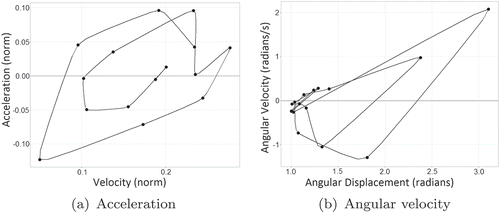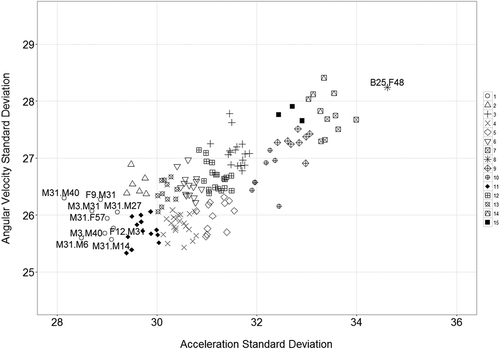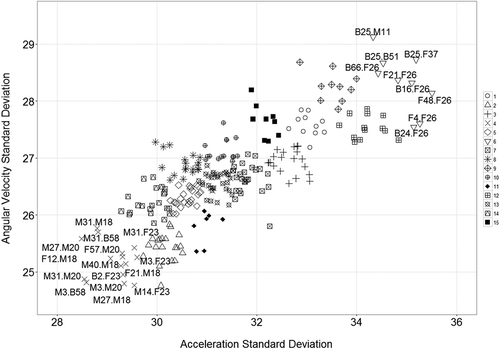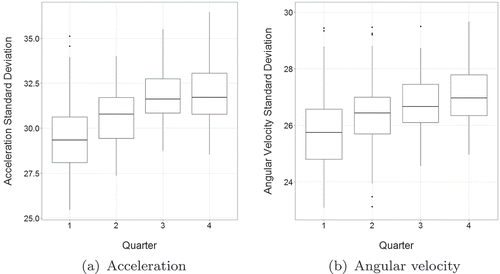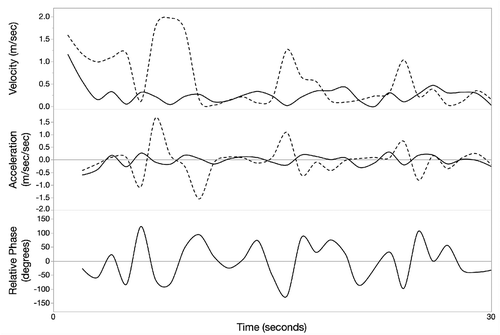 ?Mathematical formulae have been encoded as MathML and are displayed in this HTML version using MathJax in order to improve their display. Uncheck the box to turn MathJax off. This feature requires Javascript. Click on a formula to zoom.
?Mathematical formulae have been encoded as MathML and are displayed in this HTML version using MathJax in order to improve their display. Uncheck the box to turn MathJax off. This feature requires Javascript. Click on a formula to zoom.ABSTRACT
Several approaches to the modelling of interpersonal movement coordination in sports, inspired by dynamical systems, have leveraged relative proximity to fixed ground points, such as the court midline to represent the phasic characteristics of movement in competition. While these approaches are useful in highly constrained sports such as tennis and squash, Australian football (AF) is played on a much larger playing area (approximately 150 m × 100 m) and is characterized by a ‘rolling scrum’ of interpersonal contests. Consequently, a different approach to modelling pairwise movement coordination is required. We propose a method that encodes interpersonal movement coordination using relative phase properties derived from angular velocity and acceleration. We demonstrate that these properties encode the level of temporal alignment of changes in running speed and direction between player pairs. This approach is illustrated using exemplar data from AF and explores net pairwise movement coordination within and between teams, and as a function of match duration.
1. Introduction
Previous work has described the coordinated behaviour between individuals in net/wall sports such as squash [Citation1,Citation2], and later in tennis [Citation3,Citation4], and team sports such as basketball [Citation5,Citation6] and soccer [Citation7–Citation9]. In each case, these studies explored the periodicity of spatial relations between players with respect to some global feature in the playing area. McGarry and colleagues were the first to consider the spatio-temporal relationship between players in squash as a dynamical system expressed by transitions between phases of stability and instability introduced by perturbations [Citation1]. In that study, radial distances from the T location at the centre of the squash court were measured, and the successive movements of each player to and from that location formed the periodic function. In this example, proximity to the T over time provided an excellent and compact representation of the features of a rally. Similarly in tennis, Lames considered distance from the court midline and baseline as a representation of the periodic movement of players in a baseline rally, alternately moving laterally to retrieve a shot, then to the centre in preparation to return the next shot [Citation4]. These ideas were further extended to team sports by Bourbousson and colleagues, who examined spatio-temporal coordination in basketball between player dyads [Citation5] and teams [Citation6]. In that work, the phase relations were derived from the lateral and longitudinal positions of players and team centroid, respectively.
Relative phase itself provides an insight to the degree of movement coordination between players, or groups of players by using the centroid. In tennis and squash, the phase coupling compresses information about the transition from a stable rally-mode where neither player has any distinct advantage, to a transient point of instability where the climax of the point is evident. However, for team sports on much larger playing areas, the position of players in relation to some global pitch feature such as the midline is meaningless. For example, Australian rules football is played on areas that are frequently greater than 150 m × 100 m, with 36 players on field at any moment. This results in a complex set (rolling scrum) of local interactions between players that are largely unrelated to the relative positions on the pitch.
Recently, Morgan and Williams [Citation10] quantified within-team phase relations between player pairings in football (soccer) where the coordinative features were derived from acceleration and angular velocity. Acceleration can be considered a coordinative feature since players who are in-phase can be thought of changing speed (either accelerating or decelerating) in unison. Similarly, angular velocity can be considered a coordinative feature since playing pairs that are in-phase are understood to be changing direction in the same range at the same time. In both cases, anti-phase states indicate that the players within a coupling are changing speed or direction at equal rates of opposite direction (i.e. one player slows at the same rate that another player speeds, or one player turns left at the same rate another player turns right). This method permits coordinated player couplings to be described independently of the pitch location, which is a well-suited approach to large-field team sports.
Our contribution in this paper is to introduce a new method for modelling inter-player coordination in large-field team sports where the absolute positions of players to the field are not important. This paper will also explore the coordinated features of inter- and intra-team player couplings in the context of Australian rules, an invasion team sport consisting of 2 sides of 18 players competing with the objective of scoring goals (worth 6 points) and behinds (worth 1 point). Furthermore, we will confirm previous results presented in [Citation10] and examine the temporal characteristics of these relationships throughout the duration of an Australian football (AF) match.
2. Methodology
2.1. Data set
Player recordings from the TAC Cup Grand Final, the premier Under-18 AF league in Victoria, Australia, were collected. All data for the match (played between the Oakleigh Chargers and Eastern Ranges) were provided by Catapult (Catapult Innovations, Melbourne, Australia). The data set consisted of individual local positioning system (LPS) recordings for each player for the match, collected via Catapult’s wearable LPS tracking system, Clearsky. A total of 41 individual player files were used, with 5 missing due to recording complications on match day. Of the five missing players, four were members of the Eastern Ranges; hence, Oakleigh was designated as the primary team for analysis. Upon inspection, it was found that Oakleigh’s only missing player was an interchange player, hence minimizing the influence of this absence on the final findings. For this particular match, Oakleigh defeated Eastern with a score of 74 (10 goals and 13 behinds) to 61 (9 goals and 7 behinds).
Each participant’s recording included time and calibrated location. Players were classified in three primary playing positions, Midfield, Forward and Defender, based on the labels provided by team squad sheets submitted on match day. Data were de-identified for the purposes of the study with ethical permission granted to complete the study by the relevant human ethics committee.
2.2. Data preprocessing
The raw data were recorded at 10 Hz; however, the beginning of the individual player recordings was not synchronized. The recording system provided a global system time, and all data measurements included a timestamp corresponding to the global time. To resolve the temporal misalignment, the data were down-sampled to 1 Hz and temporally aligned to the nearest decisecond. The down-sampling process involved sampling the first recording at each second for all players to ensure maximal temporal alignment. In total, each player’s data set consisted of approximately 6600 rows (approximately 110 min) including time, and x- and y-location.
Game interruptions between playing periods, and the event where a player interchanged out of the competition, were inferred from the raw movement of players. Recordings for players located outside the pitch boundary were removed from the data such that only those players who were on the field of play at any given time were included in the analysis. Furthermore, only players who began the match on field were included in the analysis.
2.3. Phase angles
Quantifying phase relations involves the derivation of a performance attribute (i.e. velocity) and plotting this in relation to its rate of change. Phase angles are then derived from the slope of a point to its origin. Graphical representations of these relations are commonly referred to as phase portraits (see ,)). In this case, phase portraits were estimated by velocity and acceleration, and angular displacement and angular velocity. The equations for estimating phase angles are described below.
2.4. Phase angles for acceleration
Velocity () was derived from the raw player position data and normalized as follows, where instantaneous velocity and velocity minima and maxima are represented as
,
and
, respectively:
Acceleration () was derived from the normalized velocity:
The phase angle () for acceleration were found as a function of acceleration and velocity:
2.5. Phase angles for angular velocity
Angular displacement () was calculated as the inner product of consecutive 1-s movement vectors, a and b:
Angular velocity () follows from
:
Finally, the phase angle for angular velocity () was derived as a function of angular displacement (
) and angular velocity (
). Note that since angular displacement values spread very near to zero would result in temporally unstable phase angles, the raw angular displacements (
) are offset by a value of 1. All phase angles were converted to degrees.
2.6. Relative phase
Phase angles for acceleration () and angular velocity (
) were derived for both teams across all moments of play. Inter-team (n = 153) and intra-team (n = 270) couplings were compiled for the included on-field players. Pairwise relative phase (
) was calculated for each player couple as the difference between phase angles for acceleration and angular velocity.
Previous work in dynamical systems in sports (e.g. Ref. [Citation4]) refers to in-phase states where the relative phase is near zero, and anti-phase states where the relative phase is near ±180. The former would be true if two players were both accelerating or decelerating at equal relative rates, while the latter would be true if one player was accelerating at the same relative rate as the other was decelerating. In practical terms, both instances represent examples of coordinated behaviour, where the movements are directly coupled even though the sign of the change is inverted. Further, this logic applies equally to angular velocity, where it is the temporally coupled behaviour that we want to encode with relative phase rather than the direction itself. Therefore, we fold the tails of the relative phase distributions in such a way that moments of strong anti-phase coupling are transformed to the centre of a zero-based distribution, and in-phase and anti-phase states have equal coordinative value (see Equation 8).
2.7. Clustering
The mean and standard deviations for both acceleration and angular velocity relative phase data were calculated for each possible player coupling. Since the transformed relative phase values are centred around the mean, central tendency is not a helpful index for the between-group comparison of coordinated behaviour (since the mean relative phase will always be approximately zero). Therefore, we reason that standard deviation provides a good estimate of the level of phase coupling between players. Where the standard deviation is higher, a greater portion of moments will be characterized by out-of-phase behaviour, and where the standard deviation is lower, we reason that a greater portion of transformed relative phase moments are nearer to zero indicating greater coupling.
Given 18 players are allowed on each team, there are 630 possible permutations of player couplings at any moment. In order to reduce the complexity of this analysis, pairings were then grouped as either intra- or inter-team. Intra-team couplings consisted of all possible parings between players on the same team, and inter-team couplings consisted of all possible pairings within a team. k-Means clustering was then used to separately generate clusters of similar player couples based on their proximity in a two-dimensional space of acceleration and angular velocity relative phase standard deviations for the relevant permuted couplings. k-Means was chosen as an arbitrary method for identifying groups of high and low coordination player couples to aid in the analysis and visualization of results. These data are presented in and . k-Means works by positioning k centroids repeatedly until the means diverge and has been previously used to visualize sporting styles (e.g. see Refs. [Citation11,Citation12]). k-Clusters were chosen based on a sum of squares plot.
Figure 2. Mean relative phase standard deviations for acceleration (a) and angular velocity (b) by mean Euclidian pairwise distance.
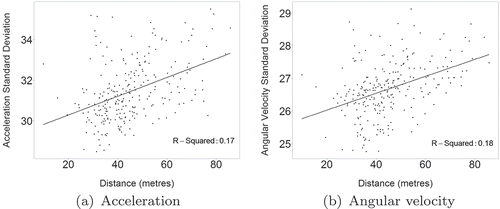
2.8. Temporal analysis
Box plots of relative phase by time period (AF games consist of four 25 min quarters) were compiled for inter- and intra-team couplings to compare mean coupling as a function of the time of the game.
3. Results
A plot of relative phase standard deviations and player proximities for all permutation of player pairs is presented in . This plot exhibits the characteristics of a positive relationship between relative phase behaviour and physical proximity on the playing area, confirming that the proximity relationships described in Ref. [Citation10] can be observed in other large-field team sports. This indicates that players who are closer to each other are more likely to move in concert, both in terms of changes in velocity ()), and in change in direction of movement ()).
3.1. Intra-team coordination
k-Means clustering for the intra-team pairings with 15 clusters is presented in . The pairs were labelled according to their playing role and shirt number, which results in a unique label for each player. The player role labels are back/defender (B), midfielder (M) and forward/attacker (F). Additionally, the mean standard deviations for acceleration and angular velocity relative phase were computed over all parings in each cluster, and the mean values are presented in .
Table 1. Mean acceleration and angular velocity cluster standard deviations for intra- and inter-team clusters.
From within the intra-team clusters, cluster 8 can be defined as the least coupled set of player pairs, while cluster 1 can otherwise be defined as the most coupled set of player pairs where the variability in phase coupling is lowest. For the purpose of comparison, we refer to cluster 1 as high-coordination pairs (HCP) and cluster 8 as low-coordination pairs (LCP).
It is worth noting that each of the player pairs observed in the HCP cluster contained at least one midfield player (M), and most of the pairs were composed of two midfielders. In contrast, the player pairs observed in the LCP cluster commonly featured pairings of players who exhibit the greatest median distance apart, indicating these are pairs of players who are positioned at opposite ends of the playing field.
3.2. Inter-team coordination
k-Means clustering for the inter-team pairings with 15 clusters is presented in . Analysis of the intra-team clusters revealed that cluster 6 can be defined as the least coupled set of player pairs, while cluster 4 can otherwise be defined as the most coupled set of player pairs. As previously described, we refer to cluster 4 and cluster 6 as HCP and LCP, respectively.
As was previously observed in the intra-team pairings, the HCP consist predominantly of midfield positions; however, they are more frequently paired with defender/back or forward players when compared to intra-team HCP. Of note, Oakleigh player M31 was part of four of the 15 HCP inter-team pairings. Inter-team LCP are largely composed of pairings of positions who are positioned at opposite ends of the field.
3.3. Temporal analysis
Box plots showing mean intra-team relative phase angle standard deviations by game quarter are presented in . The mean standard deviations over each quarter increased systematically for the acceleration relative phase () and angular velocity relative phase ()). These plots indicate that the coordinative behaviour represented by coupled changes in running speed and direction of movement decreases systematically over the course of the AF match.
3.4. Player coupling exemplars
This modelling approach encodes multidimensional movement characteristics between player pairs and can be used make pairwise classifications of players as strongly- or weakly coupled. In and , we present 30-s sequences of game play where the relative phase is derived from continuous angular displacement and angular velocity data for a weakly coupled and strong-coupled pair, respectively. While the exemplar shown in exhibits no obvious coordination, illustrates an example where the paired players are highly coordinated. Similarly, the same exemplar data are used to generate and , showing acceleration coupling between the same players. Here also, it is evident in that the players are changing speed in a highly coordinated manner, and the subsequent relative phase representation highlights both the general state of coordination and the brief moment at approximately 6 s where the velocity changes are momentarily misaligned.
Figure 6. Exemplar angular displacement, angular velocity and relative phase for a LCP player coupling (solid = B25, dashed = F48).
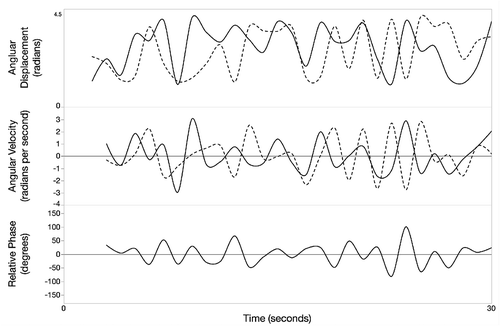
Figure 7. Exemplar angular displacement, angular velocity and relative phase for a HCP player coupling (solid = M31, dashed = F57).
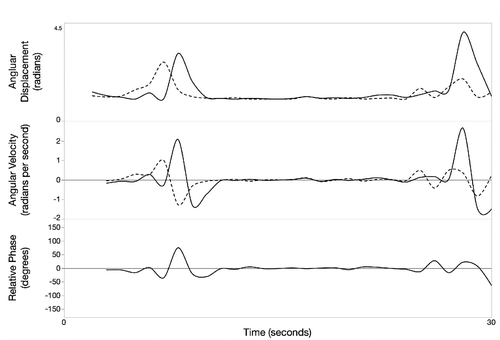
4. Discussion
This paper demonstrates a method of estimating pairwise player coupling that is suitable for team sport games, particularly games played on large playing areas. Previous approaches to estimating inter-player coordination leveraged movement features relative to fixed locations in the playing area, such as the middle ‘T’ in squash (e.g. Ref. [Citation1]). While this approach is helpful in small-court games, where the coordination of movement between players is functionally related to their physical location, the same rule may not apply in large field games. AF is played on very large surfaces and is characterized by a high number of interpersonal exchanges that are functionally independent of their location on the playing area. For instance, mid-field players can engage in a direct contest at any location on the ground, and therefore, representing their interactive movement features in a dynamical systems framework using relative phase as the principal measure of coordination requires a new approach. We studied a spatio-temporal data set in AF and illustrated exemplar results using a position-independent approach.
We demonstrated a method where phase angles are derived from separate phase portraits expressing velocity and acceleration, and angular displacement and angular velocity, respectively. The angle from the origin of a phase portrait to the momentary acceleration or angular velocity value (in polar coordinates) can be regarded as a momentary state of movement. The pairwise time-series comparison of these continuous states between players can then be used to estimate the degree of movement coordination.
The first observation we made is that there is an inverse correlation between interpersonal coordination and the distance between players. Players that are on average closer to each other are also more tightly coupled, both in terms of their changes in acceleration, and changes in angular velocity. In many respects, this is an obvious characteristic in team sports on large playing areas. Players who are further from the locus of gameplay would have no reason to move in concert with those distant players who are directly involved in the movement of the ball. This should be regarded as a sanity check and evidence of the contextual validity of our approach.
Analysis of the temporal characteristics of relative phase angles revealed that the standard deviation for the relative phase angles for both acceleration and angular velocity increases in later quarters. This indicates a potential diminishing degree structure within teams as time progresses. The decrease in coupling observed over the course of the match is also evidence that fatigue may impact the interpersonal coordination between players. This result could be explained by the proposition that as players fatigue, the variability in their capacity or willingness to run with an intensity that matches other teammates may be increased. This would predictably result in lower coupling results on that dimension.
In representing coordinative behaviour as a dynamical system, one needs to consider possible control parameters that cause a stable system to shift into some alternate state. Lames has previously asserted that the players in a tennis match could be considered as two sub-systems, strongly coupled by features of the game (such as the size and dimensions of the court, and the net-based format of the game), and characteristics of the game play (e.g. a baseline rally) [Citation4]. In many respects, AF is divorced from the structural constraints of tennis, with a large, open field of play, and without the inherent periodic construct of a net-based sport where the ball travels back and forth between players. Nevertheless, if we can consider an AF match as a system with many degrees of freedom, represented by many paired sub-systems, the stability and phase characteristics of those subsystems may be driven by match-related control parameters, such as tactical constraints, fatigue, skill-level and role-based constraints. These constraints could be considered control parameters in the sense that they cause the characteristics of pairwise behaviour to change. We may infer evidence of fatigue in the systematic degrading of coupled movements through the course of an AF match in our data. Further research should explore whether this trend is a robust feature of other matches. Similarly, tactical constraints (which are not considered here) are a potential control parameter. Consider the instance that a coach directs his/her team to play a zonal defence, where players defend spatial areas rather than specific opponent players. Such a scenario would predictably result in a substantive shift in the state of the pairwise subsystems.
Most previous system-based representations of movement coordination in sport have focussed on small court games such as tennis [Citation4], squash [Citation1] and basketball [Citation5,Citation6] (notwithstanding other work in soccer: e.g. Refs. [Citation7–Citation9]). In each instance, the order parameters considered are derived from the absolute location of individuals, or group centroids, in the playing area. This is a suitable approach to small court games, and one might argue further that even in soccer (which is played on a much larger field), role-based constraints on players assert some predictable regularity in both position and relative movement. For instance, a right-side winger will rarely wander beyond the unilateral spatial domain specific to that role. In those sports, regularity in role-based movement applies, and order parameters derived from absolute position may be helpful. In AF, however, the field-based location of players is mostly divorced from player roles (with only a few exceptions). In considering immediate derivatives of movement such as acceleration and angular velocity as order parameters, it is possible to represent coordinated behaviour in a way that is decoupled from the absolute location of players on the field of play. Importantly, this approach is not inconsistent or mutually exclusive from position-based parameters. Indeed, it may provide additional insight in a dynamical systems framework to model the combination of position and movement parameters in court and small-field games.
5. Conclusion
Our aim in this work has been twofold. Principally, we aimed to demonstrate a method for quantifying the characteristics of interpersonal movement coordination between pairs of players in large-format team sports. We extend previous innovations that use a dynamical systems framework, and relative phase, to model interpersonal movement in small-court games (where the location of players is the order parameter), and present an alternative approach that leverages derivatives of interpersonal movement that are independent of pitch location. Second, we aimed to demonstrate the observable features of pairwise coordination within and between teams in AF. This analysis revealed that movement coordination is higher amongst midfield players within the same team and direct opponents between teams, and that some aspects of interpersonal movement coordination may diminish throughout matches, perhaps due to fatigue. This approach should enable future work to learn more about potential control parameters that may direct a dynamical systems representation of large-format team sports.
Disclosure statement
No potential conflict of interest was reported by the authors.
References
- T. McGarry, M.A. Kahn, and I.M. Franks, On the presence and absence of behavioural traits in sport: an example from championship squash match-play, J Sports Sci 17 (1999), pp. 297–311. doi:10.1080/026404199366019
- T. McGarry, D.I. Anderson, S.A. Wallace, M.D. Hughes, and I.M. Franks, Sport competition as a dynamical self-organizing system, J Sports Sci. 20 (2002), pp. 771–781. Available at doi:10.1080/026404102320675620, pMID: 12363294.
- Y. Pault and P.G. Zanone, A dynamical analysis of tennis: concepts and data, J Sports Sci 10 (2005), pp. 1021–1032. doi:10.1080/02640410400021682
- M. Lames, Modelling the interaction in game sports - relative phase and moving correlations, J. Sports Sci. Med. 5 (2006), pp. 556–560.
- J. Bourbousson, C. Seve, and T. McGarry, Space-time coordination dynamics in basketball: part 1. Intra- and inter-couplings among player dyads., J Sports Sci 28 (2010), pp. 339–347. doi:10.1080/02640410903503632
- J. Bourbousson, C. Seve, and T. McGarry, Space-time coordination dynamics in basketball: part 2. The interaction between the two teams, J Sports Sci 28 (2010), pp. 349–358. doi:10.1080/02640410903503640
- J.F. Gréhaigne, D. Bouthier, and B. David, Dynamic-system analysis of opponent relationships in collective actions in soccer, J Sports Sci 15 (1997), pp. 137–149. doi:10.1080/026404197367416
- K. Davids, D. Araujo, and R. Shuttleworth, Applications of dynamical systems theory to football, Sci. football V (2005), pp. 537–550.
- W. Frenken, K. Lemmink, N. Delleman, and C. Visscher, Oscillations of centroid position and surface area of soccer teams in small-sided games, Eur. J. Sport Sci. 11 (2011), pp. 215–223. doi:10.1080/17461391.2010.499967
- S. Morgan and M. Williams, Using relative phase of position derivatives to quantify within-team player couplings, in 11th Australiasian Conference on Mathematics and Computers in Sport, MathSport, Melbourne, 2012, pp. 129–138.
- L. Gyarmati, H. Kwak, and P. Rodriguez, Searching for a unique style in soccer, in 2014 KDD Workshop on Large-Scale Sports Analytics, New York City, 2014.
- J. Sampaio, T. McGarry, J. Calleja-González, S.J. Sáiz, X.S. i del Alcázar, and M. Balciunas, Exploring game performance in the national basketball association using player tracking data, PLoS One 10(2015). doi:10.1371/journal.pone.0132894

